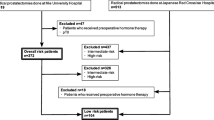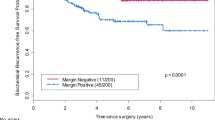Abstract
Background
To identify preoperative predictive factors for biochemical recurrence (BCR) and to further stratify its risk in high-risk localized prostate cancer patients receiving radical prostatectomy (RP).
Methods
Subjects included 195 high-risk prostate cancer patients undergoing RP from 2000 to 2012. RP consisted of retropubic radical prostatectomy and robot-assisted radical prostatectomy, involving 84 cases and 111 cases, respectively. BCR was defined as a prostate serum antigen (PSA) level ≥0.2 ng/mL. BCR-free survival (BCRFS) was calculated using the Kaplan–Meier method. Preoperative predictors of BCR were assessed with Cox’s proportional hazard regression analysis.
Results
Eighty-nine patients (45.6 %) experienced recurrence. BCRFS rates 3 and 5 years after RP were 58 and 50 %, respectively. Prostate volume, transition zone volume, and Gleason score were not significantly associated with BCR. Patients with higher preoperative PSA, PSA density (PSAD), PSA density of the transition zone, percentage of positive cores (PPC), and PPC from the dominant side showed significantly lower BCRFS. The PPC from the dominant side and PSAD were significant independent prognostic factors for BCR. Using these variables, the hazard ratio of BCR could be calculated and patients stratified into three risk groups. The 5-year BCRFS rates for Groups 1, 2, and 3 were 64.9 %, 48.1 %, and 21.3 %, respectively.
Conclusions
Patients with high-risk localized prostate cancer as currently defined do not have uniformly poor prognosis after RP. PPC from the dominant side and PSAD are significant predictors of BCR. These factors can identify high-risk patients with very poor prognosis.


Similar content being viewed by others
References
D’Amico AV, Whittington R, Malkowicz SB et al (1998) Biochemical outcome after radical prostatectomy, external beam radiation therapy, or interstitial radiation therapy for clinically localized prostate cancer. JAMA 280(11):969–974
Mitchell JA, Cooperberg MR, Elkin EP et al (2005) Ability of 2 pretreatment risk assessment methods to predict prostate cancer recurrence after radical prostatectomy: data from CaPSURE. J Urol 173(4):1126–1131
Kattan MW (2003) Nomograms are superior to staging and risk grouping systems for identifying high-risk patients: preoperative application in prostate cancer. Curr Opin Urol 13(2):111–116
Loeb S, Schaeffer EM, Trock BJ et al (2010) What are the outcomes of radical prostatectomy for high-risk prostate cancer? Urology 76(3):710–714
Freedland SJ, Aronson WJ, Terris MK et al (2003) The percentage of prostate needle biopsy cores with carcinoma from the more involved side of the biopsy as a predictor of prostate specific antigen recurrence after radical prostatectomy: results from the Shared Equal Access Regional Cancer Hospital (SEARCH) database. Cancer 98(11):2344–2350
Atzpodien J, Royston P, Wandert T et al (2003) Metastatic renal carcinoma comprehensive prognostic system. Br J Cancer 88(3):348–353
Walz J, Joniau S, Chun FK et al (2011) Pathological results and rates of treatment failure in high-risk prostate cancer patients after radical prostatectomy. BJU Int 107(5):765–770
Ploussard G, Masson-Lecomte A, Beauval JB et al (2011) Radical prostatectomy for high-risk prostate cancer defined by preoperative criteria: oncologic follow-up in national multicenter study in 813 patients and assessment of easy-to-use prognostic substratification. Urology 78(3):607–613
D’Amico AV, Whittington R, Kaplan I et al (1997) Equivalent biochemical failure-free survival after external beam radiation therapy or radical prostatectomy in patients with a pretreatment prostate specific antigen of >4–20 ng/mL. Int J Radiat Oncol Biol Phys 37(5):1053–1058
Kattan MW, Eastham JA, Stapleton AM et al (1998) A preoperative nomogram for disease recurrence following radical prostatectomy for prostate cancer. J Natl Cancer Inst 90(10):766–771
Corn BW, Hanks GE, Lee WR et al (1995) Prostate specific antigen density is not an independent predictor of response for prostate cancer treated by conformal radiotherapy. J Urol 153(6):1855–1859
Horiguchi A, Nakashima J, Horiguchi Y et al (2003) Prediction of extraprostatic cancer by prostate specific antigen density, endorectal MRI, and biopsy Gleason score in clinically localized prostate cancer. Prostate 56(1):23–29
Koie T, Mitsuzuka K, Yoneyama T et al (2014) Prostate-specific antigen density predicts extracapsular extension and increased risk of biochemical recurrence in patients with high-risk prostate cancer who underwent radical prostatectomy. Int J Clin Oncol 20(1):176–181
D’Amico AV, Whittington R, Malkowicz SB et al (2000) Clinical utility of the percentage of positive prostate biopsies in defining biochemical outcome after radical prostatectomy for patients with clinically localized prostate cancer. J Clin Oncol 18(6):1164–1172
Spalding AC, Daignault S, Sandler HM et al (2007) Percent positive biopsy cores as a prognostic factor for prostate cancer treated with external beam radiation. Urology 69(5):936–940
Grossfeld GD, Latini DM, Lubeck DP et al (2003) Predicting recurrence after radical prostatectomy for patients with high risk prostate cancer. J Urol 169(1):157–163
Cooperberg MR, Pasta DJ, Elkin EP et al (2005) The University of California, San Francisco Cancer of the Prostate Risk Assessment score: a straightforward and reliable preoperative predictor of disease recurrence after radical prostatectomy. J Urol 173(6):1938–1942
Thalgott M, Horn T, Heck MM et al (2014) Long-term results of a phase II study with neoadjuvant docetaxel chemotherapy and complete androgen blockade in locally advanced and high-risk prostate cancer. J Hematol Oncol. doi:10.1186/1756-8722-7.20
Narita S, Tsuchiya N, Kumazawa T et al (2012) Short-term clinicopathological outcome of neoadjuvant chemohormonal therapy comprising complete androgen blockade, followed by treatment with docetaxel and estramustine phosphate before radical prostatectomy in Japanese patients with high-risk localized prostate cancer. World J Surg Oncol. doi:10.1186/1477-7819-10.1
Kim WY, Whang YE, Pruthi RS et al (2011) Neoadjuvant docetaxel/estramustine prior to radical prostatectomy or external beam radiotherapy in high risk localized prostate cancer: a phase II trial. Urol Oncol 29(6):608–613
Grimm P, Billiet I, Bostwick D et al (2012) Comparative analysis of prostate-specific antigen free survival outcomes for patients with low, intermediate and high risk prostate cancer treatment by radical therapy. Results from the Prostate Cancer Results Study Group. BJU Int 109(Suppl 1):22–29
Author information
Authors and Affiliations
Corresponding author
Ethics declarations
Conflict of interest
The authors declare that they have no conflict of interest.
About this article
Cite this article
Hamada, R., Nakashima, J., Ohori, M. et al. Preoperative predictive factors and further risk stratification of biochemical recurrence in clinically localized high-risk prostate cancer. Int J Clin Oncol 21, 595–600 (2016). https://doi.org/10.1007/s10147-015-0923-3
Received:
Accepted:
Published:
Issue Date:
DOI: https://doi.org/10.1007/s10147-015-0923-3




